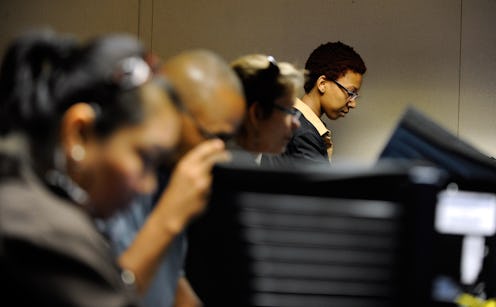News
Nevada Caucus Voters Are More Diverse Than Iowa
As Republicans face off in South Carolina on Saturday, Feb. 20, Democrats head to Nevada to see how they fare among voters in the West. During the first caucus of the season in Iowa, Hillary Clinton and Bernie Sanders came out nearly tied in the poll results. In the New Hampshire primary, Sanders emerged the Democratic frontrunner with a 22-point lead over Clinton. However, one important conversation around both of these voting events focused on voter demographics in each state and how that could influence the results. Non-hispanic whites make up 87 percent of Iowa's population, and they represent 91 percent of the population in New Hampshire, according to the U.S. Census Bureau. Now as the country shifts its political focus to the West, the next Democratic caucus will be much more diverse, as Nevada's population is nearly half non-white.
These three states also differ greatly in political party demographics; Iowa is politically diverse despite being racially homogenous and the "first in the nation" primary is characterized by the notorious New Hampshire undecided voters. Once again, Nevada stands out from these two states in that it has supported both Democratic and Republican candidates in the past, yet is projected to lean-left in upcoming presidential elections. Here's a breakdown of the three state's racial and political demographics to show how Nevada differs.
Iowa
With a population that is 87 percent white, Iowa's racial demographics are fairly homogenous. In the 2012 Iowa caucus, among the Republican participants, 99 percent were white, and 57 percent were male. Despite the lack of racial diversity, the Iowa caucus results are always interesting because of the state's bipartisan voters.
According to FiveThirtyEight, in heavily Democratic precincts around Iowa, Republicans are competitive and the same goes with Democrats in Republican-dominated areas. Similarly, Democrats outnumbered Republicans in 2008, but that flipped in 2012 when Republicans gained majority representation. Historically, voter turnout has been low at the Iowa caucus because only registered party members can vote, but that doesn't change the racial and political demographics that shape the state's caucus results.
New Hampshire
New Hampshire's population is 91 percent white, leaving little room for diversity among primary voters. However, similar to Iowa, its lack of racial diversity is not reflected in its political diversity. A WBUR poll reported that among political party affiliations, there were 44 percent undeclared voters just three weeks before the Feb. 9 New Hampshire primary.
The largely Independent and undeclared voters' impact was made clear when the primary results showed how the "outsider" candidates swept a victory in the polls. Although Donald Trump won, Ohio Gov. John Kasich surged to an unexpected second place, trailed by Ted Cruz (who won the Iowa caucus) and Jeb Bush (who took sixth in Iowa). New Hampshire may be criticized for its mostly-white population, but its undecided voters take the process seriously, and the unexpected results show they don't just follow their midwestern predecessor's lead.
Nevada
Unlike both Iowa and New Hampshire, Nevada is one of the most diverse states in the country. Nearly 30 percent of its population is Latino, which is much higher than the 17 percent national average; its 8.3 percent Asian American population also exceeds the national average, and African Americans make up 9 percent of the population. When just 51 percent of the population is white, it is important that these minority voters show up to participate in the caucus — and they do. In 2008, minorities represented 38 percent of caucus voters, according to an ABC News exit poll. (That minority representation is a remarkable difference from the 99 percent white Republican voters in the 2012 Iowa caucus.)
As minority populations have grown over the years, so has Nevada's support of Democratic presidential candidates. In 2004, Nevada's Latino voters selected a Democrat, John Kerry, over George W. Bush by a 22-percentage-point lead. In 2008, Barack Obama swept 55 percent of the votes, once again giving a win to the Democrats in Nevada.
Fun fact: Nevada's diverse demographics are actually the reason its caucus is at the beginning of the early-voting primary calendar. U.S. Senator Harry Reid advocated for a state with better demographic representation to balance out the majority white states like Iowa and New Hampshire.
